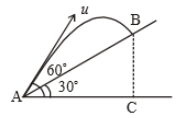A particle is projected at an angle with horizontal with an initital speed u. When it makes an angle with horizontal, its speed v is-
1.
2.
3.
4.
A particle is moving along the path y = from x = 0 m to x = 2 m. Then the distance traveled by the particle is:
1. 4 m
2.
3.
4.
Six particles situated at the corners of a regular hexagon of side \(a\) move at constant speed \(v\). Each particle maintains a direction towards the particle at the next. The time which the particles will take to meet each other is:
1. \(\frac{2 a}{v}~\text{sec}\)
2. \(\frac{a}{v}~\text{sec}\)
3. \(\frac{2 a}{3v}~\text{sec}\)
4. \(\frac{3 a}{v}~\text{sec}\)
A body is projected with velocity m/s with an angle of projection 60 with horizontal. Calculate velocity on that point where body makes an angle 30 with the horizontal.
1. 20 m/s
2.
3.
4. 10 m/s
In a uniform circular motion, which of the following quantity is not constant
1. Angular momentum
2. Speed
3. Kinetic energy
4. Momentum
A particle is moving with veocity ; where k is constant. The general equation for the path is:
1.
2.
3.
4. xy=constant
A particle is projected with a velocity u making an angle with the horizontal. At any instant, its velocity v is at right angles to its initial velocity u; then v is:
1. ucos
2. utan
3. ucot
4. usec
A projectile is given an initial velocity of . The cartesian equation of its path is (g = 10 )
1.
2.
3.
4.
A ship A is moving westwards with a speed of 10 km and a ship B, 100 km south of A is moving northwards with a speed of 10 km . The time after which the distance between them becomes the shortest, is:
1. 5 hr
2. hr
3. hr
4. 0 hr
Time taken by the projectile to reach from A to B is t. Then the distance AB is equal to :


1.
2.
3.
4. 2ut






